any time now
Benign Prostatic Hypertrophy (BPH)
Nutritional Supplements May Help Prevent and Reduce Benign Prostatic Hypertropy
by Ladd McNamara, M.D.
Discussion

The article and protocols on this website are for informational purposes only, and not intended as medical advice. Please consult your personal licensed health care provider prior to taking supplements or acting upon information contained herein. Please read full medical disclaimer below.
Nutritional supplements, if taken in the right spectrum, dosages, and purity can and do help reduce the incidence and severity of several symptoms of benign prostatic hyperplasia (BPH), in many cases just as well as some medications. There are several effective treatments for prostate gland enlargement, including medications, minimally invasive therapies, and surgery. In this article, I will review what we know about BPH and which supplements can be used for those who wish to avoid the side effects of medications, and hopefully surgical treatments.
The Prostate
A normal prostate gland is about the size of a walnut, which is situated directly below the male bladder. 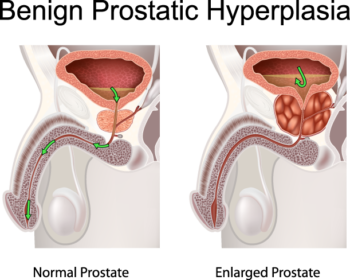 The urethra is the tube through which urine flows from the bladder to the end of the penis. The urethra passes right through the center of the prostate gland, which is why urine flow can be altered when the prostate gland enlarges.
The urethra is the tube through which urine flows from the bladder to the end of the penis. The urethra passes right through the center of the prostate gland, which is why urine flow can be altered when the prostate gland enlarges.
The function of the prostate gland is to secrete seminal fluids (semen) that provide nourishment for sperm motility. Sperm is produced in the testes, and semen is produced by the glandular cells of the prostate. Much like glandular cells of the breasts, which are sensitive to hormones, the prostate glandular cells are sensitive to both estrogen and testosterone. The glandular cells and epithelial cells of the prostate are at risk of over-growth, known as hyperplasia or hypertrophy, as well as cancer development.
Enlargement of the Prostate
After age 40, the prostate gland begins to enlarge due to an increase in the number of cells (hyperplasia). A variety of factors, including androgens (male hormones), estrogens, growth factors and other cell signaling pathways usually leads to benign overgrowth (hypertrophy).

Although men’s free testosterone levels decline after 30, and more so after 40, a stronger form of testosterone, di-hydro-testosterone (DHT) increases slightly, which causes a significant change in the free testosterone-to-DHT ratio. DHT is a factor in acne, excessive skin oil, male-pattern baldness, development of BPH, and prostate cancer.
As the prostate grows larger, it may press on the urethra. This narrowing of the urethra can cause some men with prostate enlargement to have trouble with urination. Prostate enlargement may be the most common health problem in men over 60 years of age.
In the early stage of prostate enlargement, the bladder muscle has to contract ever more strongly to overcome the resistance from a constricted urethra; and it becomes thicker as it works harder to empty the bladder. As a result, the bladder muscle is sensitized to contract powerfully and early in bladder filling, causing a man to urinate more often and more suddenly.
As the prostate grows larger and the urethra is constricted more tightly, the bladder might not be able to completely empty. In some cases, blockage and backflow of urine due to a narrow urethra may cause frequent lower and upper urinary tract infections and gradually result in bladder or kidney damage.
Symptoms of BPH
The severity of symptoms tend to worsen over time. Common signs and symptoms of BPH include:

- Frequent and sudden need to urinate
- Waking from sleep to urinate (nocturia)
- Difficulty starting urine flow
- Weak urine stream, or a stream that stops and starts
- Dribbling at the end of urination
- Inability to completely empty the bladder
Risk factors for prostate gland enlargement include
- moderate to severe symptoms of BPH. By age 80, over 80% of men experience symptoms of BPH.
- Lifestyle: Inactivity and obesity, both of which increase inflammation in the body, increases your risk of BPH; while exercise can lower the risk.
- Family history: Having a father or brother with prostate problems increases your risk.
- Ethnic background: BPH is most common in black men, then white, and then Asian men.
- Diabetes and heart disease. Diabetes and heart disease increases the risk of BPH, mainly due to an increase in inflammation and oxidation, as well as calcifications of the blood vessels going to the prostate.
- Lack of Dietary Micronutrients: Vitamins, minerals, omega-3 fatty acids, and particularly antioxidants all help support and maintain the health of all tissues and organs in the body, and quell inflammation and oxidation. The lack of optimal levels of micronutrients can therefore be considered a risk factor.
Increase in PSA
Prostate-specific antigen (PSA) is a protein produced by prostate cells. PSA blood levels increase simply because there are more prostate gland cells when the prostate is enlarged. However elevated PSA levels can also be due to recent prostate procedures (e.g., prostate exam or biopsy), a prostate infection (prostatitis), and especially prostate cancer. PSA levels are followed during treatment of prostate cancer as a means to determine the trend of whether prostate cancer cells are increasing or decreasing in number.
Benign Prostatic Hyperplasia Therapies
Medication is the most common treatment for mild-to-moderate symptoms of prostate enlargement. The options include:
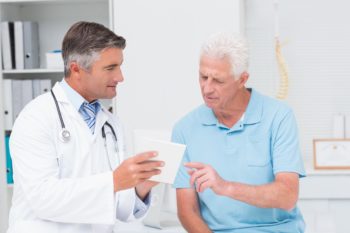 Alpha blockers: This class of medications relaxes the bladder neck muscles and muscle fibers in the prostate, making urination easier. Alpha blockers, which include alfuzosin (Uroxatral), doxazosin (Cardura), tamsulosin (Flomax), and silodosin (Rapaflo) — usually work well in cases of mild BPH. However, the side effects include dizziness and possibly retrograde ejaculation; a condition in which semen is ejaculated into the bladder instead of out the tip of the penis.
Alpha blockers: This class of medications relaxes the bladder neck muscles and muscle fibers in the prostate, making urination easier. Alpha blockers, which include alfuzosin (Uroxatral), doxazosin (Cardura), tamsulosin (Flomax), and silodosin (Rapaflo) — usually work well in cases of mild BPH. However, the side effects include dizziness and possibly retrograde ejaculation; a condition in which semen is ejaculated into the bladder instead of out the tip of the penis.- 5-alpha reductase inhibitors: These medications shrink your prostate by inhibiting the conversion of testosterone to di-hydro-testosterone (DHT). This includes finasteride (Proscar) and dutasteride (Avodart); which might take up to six months to cause enough shrinkage of the prostate to be effective. (Saw palmetto is an herb, and a natural 5-alpha reductase inhibitor that works just as well as the medications, without the side effects.)
- Combination drug therapy: Your doctor might recommend a combination of an alpha blocker and a 5-alpha reductase inhibitor if either medication alone isn’t effective.
- Tadalafil (Cialis): This medication used to treat erectile dysfunction can also lessen prostate enlargement. Daily Cialis may be a good option to take for both BPH and erectile dysfunction.
Surgical therapies might be recommended if medications do not work and/or the symptoms worsen. Of course, any type of prostate procedure can cause side effects and complications. Such complications include:
- Retrograde ejaculation into the bladder.
- Urinary tract infections
- Erectile dysfunction
- Rarely, a loss of bladder control (incontinence)
There are several types of minimally invasive or surgical therapies, which you can discuss with your doctor if needed.
Symptom Management Strategies
There are several things you can try to help control the symptoms of BPH, which do not require drugs or surgery; or, may be used to enhance the efficacy of a medication.
- Limit beverages in the evening. Don’t drink anything for an hour or two before bedtime to avoid waking up to urinate.
 Limit caffeine and alcohol. Not just at night, but reduce the intake, or eliminate them completely all day, as they increase urine production, irritate the bladder and worsen symptoms.
Limit caffeine and alcohol. Not just at night, but reduce the intake, or eliminate them completely all day, as they increase urine production, irritate the bladder and worsen symptoms.- Limit decongestants or antihistamines. These drugs cause a spasm of the muscles within the wall of urethra, making it harder to urinate.
- Go to the bathroom when you first feel the urge to pee. Waiting too long might overstretch the bladder muscle and worsen the symptoms.
- Lose weight. Obesity is associated with enlarged prostate.
- Follow a healthy diet and stay active. Inactivity increases urinary retention.
- Take nutritional supplements. Vitamins, minerals, antioxidants, and fish oil, and especially a supplement as is in my protocol below, which provides saw palmetto, lycopene, and soy isoflavones. All these reduce inflammation, a factor in the development and progression of BPH, as well as help shrink an enlarged prostate gland.
- A “vision support” support supplement that provides carotenoids, lutein and zeaxanthin, as well as bilberry extract, helps prevent and reverse prostatic hyperplasia, and its related symptoms. In fact, these carotenoids have a myriad of benefits, including reducing the risk of cardiovascular disease, dementia, and skin disorders, along with macular degeneration, cataracts, and glaucoma.
Nutritional Supplements and BPH
Traditionally, most doctors will say that supplements do not work. This is due to two factors:
- Studies of supplements for BPH show mixed results; but they have only evaluated a single nutrient or herb, and did not account for a broad spectrum of various micronutrients in a pure and potent form. The studies that evaluated a combination of micronutrients all demonstrate benefits.
- Doctors are exposed to Big Pharma’s method of managing everything via medications. There is big money in medications, so there is a big push to make drugs the “standard of care” for all things wrong in the body.
Over the past two decades, despite beginning my career in obstetrics and gynecology, I have been suggesting that men make lifestyle changes, including adhering to a high-quality, potent and pure nutritional supplement program to help decrease the risk of many chronic diseases, including BPH. My transition into nutraceutical medicine in 1995 allowed me to witness remarkable results among my hundreds of patients and several thousands of others worldwide.
Nutritional Supplements Work Synergistically
My intention in this article is not to name each micronutrient and how it can help prevent and manage BPH. I only intend to cite some micronutrients, and how research has demonstrated a positive effect on the prostate. There are thousands of studies showing how micronutrients help reduce the incidence and progression of prostate cancer, but since BPH is not associated with an increased risk of prostate cancer, I will only focus on the studies involving BPH.
Vitamin D
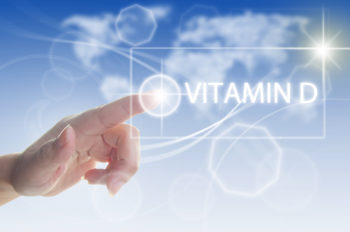
There is a vitamin D deficiency epidemic, and studies have shown that low vitamin D status is associated with an increased risk of prostate cancer and BPH. (1 – 3) Scientific evidence suggests that boosting vitamin D blood levels to more optimal levels are associated with a reduced risk of prostate cancer and BPH. (4, 5)
Those who have read my article on Vitamin D will know that I advocate that people maintain their vitamin D blood levels well above 50 ng/ml. Many doctors are now recommending their patients maintain a vitamin D blood level of 50 ng/ml; however, after looking at the research on what is effective and safe, the target blood level for vitamin D that I suggest is closer to 75 ng/ml. There are no reports of any health problems or negative effects from taking vitamin D3 up to 10,000 IU/day, and maintaining a vitamin D blood level of up to 100 ng/ml.
Blood calcium and parathyroid hormones may play a role in the development of BPH; indicating that there is not just one simple factor that leads to BPH, but a complex interplay between calcium metabolism, aldosterone actions, vitamin D, estrogen, androgenic hormones, and inflammation/oxidation.
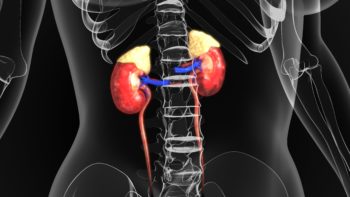
Aldosterone is a hormone produced in the adrenal glands, which are located above the kidneys. Aldosterone plays a role in regulation of blood pressure. It influences the kidneys (i.e., the renin-angiotensin system) and colon to retain sodium in the blood, increasing the osmotic pressure to reabsorb water, as well as the amount of potassium released in the urine, all for the purpose of regulating blood volume and blood pressure. Indirectly, the hormone also helps maintain the blood’s pH and electrolyte levels.
A study in 2014 demonstrated that a combination of vitamin D deficiency and elevated aldosterone levels that affect the renin-angiotensin system play a role in BPH development. (6) This provides a basis for why supplementation with micronutrients would help prevent and help treat BPH.
BPH development is a dysfunction of a fine network of hormones and micronutrients, rather than a failure of a particular substance. This is why no single nutrient or medication prevents or cures benign prostatic hyperplasia.
Vitamin K2
All treatments for BPH to date are based on symptomatic relief, not a fundamental understanding of the cause of the disease. Recent studies have shown that small varicoceles (enlarged blood vessels in the scrotum, similar to varicose veins), which are more common than generally realized, increase blood flow from the testes to the prostate gland, exposing the prostate gland to a 130-fold increase in free testosterone. Some of the free testosterone is converted to a stronger form of testosterone, DHT, by the enzyme 5-alpha reductase in the prostate, which causes prostate cell proliferation.
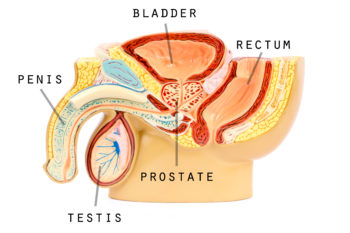
So what causes small varicose veins in the scrotum? Recent research has demonstrated the role of vitamin K2 in the calcification of varicose veins, as well as in the proliferation of smooth muscle cells in the vein wall. Vitamin K2 deficiency is involved in the formation of varicose veins, and is a factor in the development of BPH. (7)
The hypothesis of the researchers in that study concluded that poor prostate health is essentially a vitamin K2 insufficiency disorder. By providing vitamin K2 in the right form (MK7) and quantity along with other supporting nutrients, such as vitamin D, lycopene, lutein, zeaxanthin, grape seed extract, resveratrol, curcumin, N-acetyl-L-cysteine, alpha lipoic acid, broccoli extract, olive extract, green tea extract, saw palmetto, and soy isoflavones, it is likely that BPH can be prevented, or at least inhibited from getting worse.
Saw Palmetto

Saw palmetto has been shown to reduce the incidence and severity of BPH. (60 – 62) Saw palmetto is an herbal supplement derived from the fruit of the small palm plant, Serenoa repens. It is rich in fatty acids and phytosterols.
The saw palmetto fatty acids have the ability to block the enzyme 5-alpha reductase, which converts testosterone into di-hydro-testosterone (DHT), a strong androgenic hormone that can cause hair loss in genetically susceptible men, and less often, women. It can also cause acne and oily skin in either men or women, particularly those with higher concentrations of 5-alpha reductase in their skin.
Since the prostate also has a high concentration of 5-alpha reductase enzymes, an increase in DHT stimulates the development of BPH. Saw palmetto inhibits 5-alpha reductase, which reduces DHT production, which in turn removes the stimulus to cause BPH. It is especially helpful when taken with other micronutrients. Saw palmetto also helps reduce the incidence of lower urinary tract symptoms, i.e., bladder and prostate infections in men. (8)
As mentioned already, BPH is associated with inflammation. This is due to increased COX-2 enzymatic activity within the prostate gland. (9 – 11) In addition to inhibiting 5-alpha reductase enzyme, saw palmetto inhibits the COX-2 enzyme, which is involved in inflammation. (12) This provides yet another mechanism by which saw palmetto may slow both the development and progression of BPH and prostate cancer. (BPH by itself has not shown to be directly associated with an increased risk of prostate cancer; but the same factors that lead to one disorder can lead to the other.)
The combination of saw palmetto and other micronutrients, e.g., lycopene, soy isoflavones, and vitamin D, effectively reduces BPH symptoms of urinary frequency, urgency, and nocturia. It also improves urine flow-rate. (13, 14)
Lycopene

Lycopene is a carotenoid red-orange pigment, responsible for giving color to many fruits and vegetables. It is abundant in tomatoes, but also red carrots, watermelons, papayas and pink grapefruit. Lycopene is a powerful antioxidant, and research has shown that it helps prevent heart disease, atherosclerosis, skin aging, and lung, colon, liver, breast and prostate cancers. (15 – 17) Lycopene may boost sperm count in men with infertility. And, in relationship to this article, studies have shown that lycopene plays a role in BPH prevention and regression.
Lycopene alone or in combination with selenium and saw palmetto, inhibits abnormal prostate cell growth, angiogenesis, and induces apoptosis of abnormal cells. Therefore, it is useful in the treatment of prostate cancer and BPH. (18 – 22)
However, the combination of micronutrients is significantly more effective in the induction of apoptosis, and preventing urinary symptoms and bladder infections than any of the micronutrients individually. The combination of micronutrients makes certain medications to help with urinary flow more effective than the medication alone. (23)
Vitamin C and Vitamin E
An animal study has shown that vitamin C inhibits DHT-induced BPH. (24) In a 3-month placebo-controlled study, a combination of saw palmetto, beta-sitosterol, vitamin E, and pollen extract, was shown to decrease many of the symptoms of BPH over the course. (25)
Vitamin E is known as tocopherol. Not all vitamin E is the same. Some formulations of vitamin E might actually work against you, while the proper formulation of the various tocopherols (vitamin E) works in your benefit by reducing the risk of many chronic diseases, including reducing the growth and inhibiting the spread of cancer.
Vitamin E is known as tocopherol, with the various forms of tocopherol, alpha, gamma, beta, and delta. There are also tocotrienols, which are all found in the natural state of vitamin E. Cheaper productions of vitamin E are derived from petroleum-tar distillates, and provide only alpha tocopherol in both the D and L isomeric forms. That is, there is a “right-handed” (D) and “left-handed” (L) molecular form (isomer) of alpha tocopherol. However, your cells only recognize the “right-handed” isomer, that is, the “D” structure. Therefore, you should select a supplement that not only provides the “D” isomeric formulation of alpha tocopherol; but also, a brand that provides a wide array of tocopherol subtypes; beta, gamma, delta, etc.
Armed with this information about the differences between the various forms of vitamin E, don’t let anyone tell you that vitamin E is harmful; unless they qualify it as only the synthetic form, D,L-alpha tocopherol, which may be harmful. Avoid that form.
Green Tea Extract (EGCG)
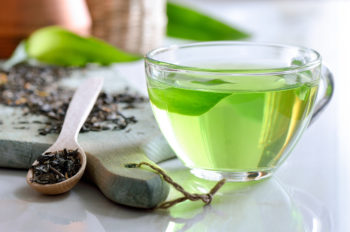
The cancer-preventive activities of catechins, as found in green tea, have been extensively studied. Of these, (-)-epigallocatechin-3-gallate (EGCG), the principal catechin in green tea, has received the most attention. Green tea extract provides EGCG and other catechins. Many studies in the laboratory have demonstrated inhibition of both cancer development and cancer progression by green tea catechins.
Green tea extract has shown to reduce the risk of cancer (including prostate cancer) and of BPH by inhibiting the COX-2 enzyme, reducing inflammation, protecting against free radical oxidative damage, and inhibiting abnormal cellular growth. (26)
Grape Seed Extract

There are numerous studies extolling the benefits of grape seed extract in the preventing and adjunctive treatment of many cancers, including prostate cancer. (27 – 33) I have not found a study evaluating the effectiveness of grape seed extract for the prevention and reduction of symptoms of BPH. However, given the mechanism of action for the prevention and destruction of prostate cancer cells, there is no reason that the same mechanism would not apply for BPH. And, given the results I have seen for over 20 years of recommending grape seed extract, I feel it is a critical nutrient in my protocols.
Not all grape seed extracts have the same purity or potency. Most people purchase grape seed extract over the counter, and do not see any significant results. Most grape seed extract brands have such a low potency and purity, it is a wonder how they are able to get away with calling it grape seed extract.
For grape seed extract to have any significant effect, it needs to have at least a potency of 80% of the active ingredients. That means, for every 100 mg of grape seed extract, at least 80 mg needs to be pure, bio-active proanthocyanidins and monomers. Most brands provide grape seed extract with a potency of 10 – 15% proanthocyanidins, and no monomers at all.
The brand of grape seed extract I use and recommend has 93 – 95% potency of both proanthocyanidins and monomers. A higher potency and purity brand does not exist. This is the reason I have seen such dramatic results when I use higher doses of this grape seed extract, and why it is part of almost all of my protocols to maintain and support optimal health.
Resveratrol is a natural polyphenolic antioxidant from the red grape, just like grape seed extract. It is well known for its cardio-protective, anti-cancer, and anti-inflammatory properties. It has also been shown to prevent overgrowth, or hyperplasia of the prostate (helps prevent and reverse BPH). (34)
Soy Isoflavones
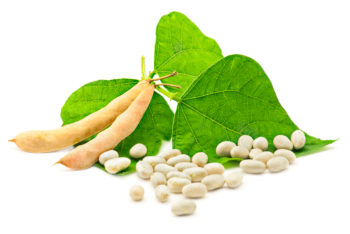
In the United States, African American men have a 60% higher risk of developing BPH and prostate cancer. Hispanic men have a lower risk than Caucasians. Asian and Indian men living in their respective original countries, have a significantly lower risk of BPH and prostate cancer, but that lowered risk evaporates when these men adopt a typical “American” or Western diet. (35)
Asians consume more soy than a typical Western diet, which apparently accounts for the lower incidence of both BPH and prostate cancer in men, and a low incidence of breast cancer in women. (36)
Isoflavones are phytoestrogens that have recently gained interest as dietary factors related to prostatic diseases. Studies have shown that those with the most advanced cases of BPH, requiring removal of the prostate, were found to have the least tissue concentration of soy isoflavones, and that those with milder cases had higher tissue concentrations. (37) This is evidence that isoflavones help reduce the severity of BPH. One soy isoflavone, genistein, has been shown in the laboratory to inhibit growth of human-patient BPH and prostate cancer cells. (38)
Soy isoflavones are selective estrogen receptor modulators. (39) That is, soy isoflavones act as both estrogen receptor agonists (stimulators) to directly benefit the heart, arteries, and bones, and as estrogen receptor antagonists (blockers), protecting against breast and endometrial cancers in women, and BPH and prostate cancer in men. (40 – 45)
Prostate cells have estrogen receptors. A rise in estrogen as a man ages is associated with BPH and prostate cancer. Using an effective estrogen blocker, such as soy isoflavones would therefore help reduce the risk of both BPH and prostate cancer. As mentioned earlier, soy isoflavones are more effective if working synergistically with saw palmetto and lycopene.
Turmeric Extract (Curcumin)
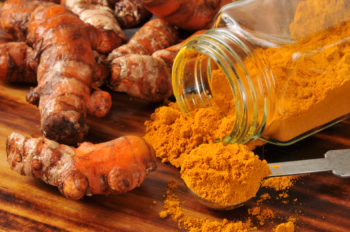
Curcumin, or turmeric extract, is derived from the Indian spice turmeric and possesses several active components, all of which contribute to its anti-inflammatory and chemo-preventive power. (46) Impressively, it causes cancer cells to be more sensitive to chemo or radiation therapy, allowing more effective cancer killing and at the same time, blocks damage of cancer therapy to normal cells. (47 – 51)
Curcumin has been shown to have powerful anti-proliferative effects on prostate cells, inhibiting prostate cancer and benign prostatic hyperplasia. (52) Curcumin even inhibits DHT production by down-regulating the 5-alpha reductase enzyme. (53) Curcumin demonstrated the same inhibition of DHT production as the medication finasteride (Proscar), preventing cellular abnormalities and reducing prostate size, without the side effects of the medication. (54)
Meriaâ brand is a special-formulated, highly absorbable preparation of curcumin, 30 – 60 times more absorbable than standard curcumin preparations. It demonstrated a reduction of BPH symptoms of urine flow restriction and lower urinary tract infections (bladder and prostate) without any side effects. (55)
Since there is no known toxic dose to turmeric extract, I believe every person should be taking curcumin, which is in the “liver support” supplement, as well as in the “joint support” supplement in some of my protocols.
As mentioned above, inflammation is a key component of cancer and BPH development and progression. Turmeric extract (curcumin), grape seed extract, and olive extract are particularly good at suppressing inflammation via inhibition of the COX-2 enzyme, inhibiting angiogenesis, and inducing apoptosis. All micronutrients work better together than any of them separately.
Beta-Glucans (Derived from Mushrooms and Baker’s Yeast)

Beta glucans have shown a diversity of bioactivities involving anticancer, immunomodulatory and anti-inflammatory effects. Beta-glucans are polysaccharides (glucose modules) derived from the cell membranes of the Reishi and Shiitake mushrooms, as well as from baker’s yeast extract (Saccharomyces cerevisiae), which have been found to have powerful immunomodulating properties, meaning they help kick the immune system into high gear to fight off foreign invaders that would cause infection. They also help kill abnormal cell development and growth, including hyperplasia and cancer cells. (56, 57)
The beta glucan polysaccharides are a type of fiber that do not break down in the stomach, and therefore do not have any impact on blood glucose levels and do not add calories. Of note, beta glucans increase damage to abnormal prostate cells, inducing apoptosis. (58)
Beta-glucans distinct molecular structure allows them to bind to receptors on cell membranes of white blood cells, including cytotoxic T cells, macrophages, and natural killer cells, and to cause cell death of many types of cancer, including prostate, lung, and breast cancer cells. (59, 60)
Macrophages are white blood cells that “eat up” and “digest” bacteria or cancer cells; and natural killer cells are white blood cells that kill abnormal cells by triggering the release of cytokines to dissolve the cell membranes of abnormal cells, inducing apoptosis.
Beta-glucans work synergistically with other supplements, to work better together to destroy abnormal cells. Some of the micronutrients shown to work synergistically with beta-glucans are resveratrol, vitamin C, selenium, and melatonin; but there is no reason that adding all other micronutrients would not produce a similar or greater effect. (61 – 63)
Supplement Protocols for Benign Prostatic Hyperplasia (BPH)
I have created what I consider to be the minimal – high-dose protocols for benign prostatic hyperplasia. Which one to follow is up to you, based upon how severe the symptoms are, and what levels work for you. One suggestion would be to start with a higher dose than you think may be necessary, and then taper down after 3 months. However, if after tapering down your symptoms worsen, increase the dosages again. Through this titration method you will find what works best for you. There is no toxicity with any of these doses.
The article and protocols on this website are for informational purposes only, and not intended as medical advice. Please consult your personal licensed health care provider prior to taking supplements or acting upon information contained herein. Please read full medical disclaimer below.
Minimal Protocol for BPH

Basic Protocol for BPH
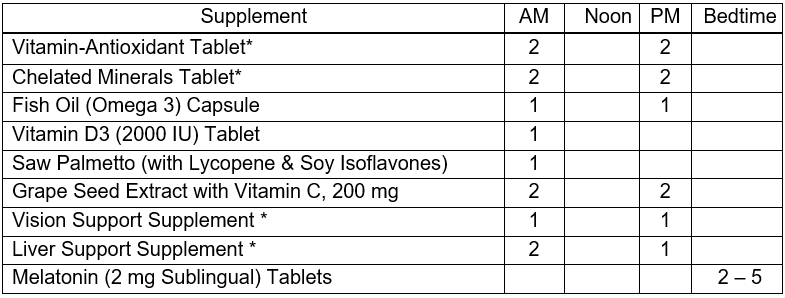
Average Protocol for BPH
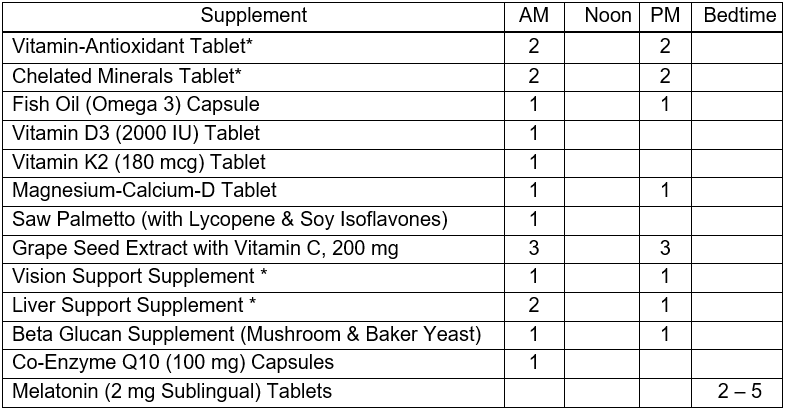
Advanced Protocol for BPH
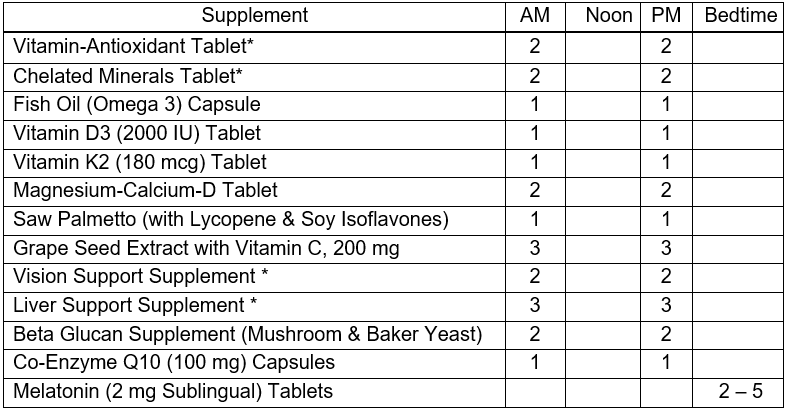
- AM: With, or after breakfast
- Noon: At lunchtime with food, or shortly thereafter
- PM: Late afternoon with food, or at, or after dinner
- Please see my list of ingredients (below) that I like to see provided by a foundational vitamin and mineral supplement.
- Saw Palmetto Prostate Support Supplement that provides: 320 mg of saw palmetto, 5 mg of lycopene, 25 mg of soy isoflavones. Boron is provided in the basic chelated minerals in the protocol, along with other antioxidants in the vitamin-antioxidants and the “liver support” supplement.
- Vision Support Supplement that provides at least lutein, zeaxanthin, bilberry extract, vitamin C, and zinc.
- Vitamin K2 is usually found in a foundational multi-mineral supplement, and it is also provided as a stand-alone product, usually as 180 mcg tablet. Taking at least one per day is for preventative use; that is to prevent cardiovascular disease, and osteoporosis, as well as to help prevent BPH, along with other micronutrients. When BPH is present, consider 360 to 1,800 mcg per day of vitamin K2. There is no known toxic dose; and it also has benefits for the arteries and bones.
- Liver support supplement provides numerous ingredients, including N-Acetyl-L-Cysteine (NAC), turmeric extract (curcumin), green tea extract, olive extract, broccoli extract, alpha lipoic acid, milk thistle extract, and biotin.
- Beta Glucan Supplement, derived from extracts of reishi and shiitake mushrooms, as well as baker’s yeast extract. This is a powerful immune support supplement, giving it anticancer effects. It also has anti-inflammatory effects, and animal studies indicate that it may be beneficial for BPH therapy.
Ingredients that I like to see provided collectively by vitamin-antioxidant & chelated mineral tablets
Vitamin A, mostly as Beta Carotene
Vitamin C
Vitamin D3
Vitamin E
Vitamin K (K1 & K2)
B-Complex Vitamins
Curcumin (turmeric extract)
Quercetin
Green Tea Extract
Olive Extract
Rutin
Resveratrol
Choline
Lutein
Lycopene
N-Acetyl-L-Cysteine (NAC)
Calcium
Magnesium
Iodine (as potassium iodide)
Zinc
Selenium
Copper
Manganese
Chromium
Molybdenum
Including Ultra Trace Minerals
Medical Disclaimer:
Information on this website, written, spoken, or in any other communication by Dr. Ladd McNamara or any other information or reference is for informational purposes only. The information provided on this website is a result of years of practice, experience, and study by the author. This information is not intended as a substitute for the advice provided by someone’s personal licensed physician or other healthcare professional, or any information contained on or in any product label or packaging. Do not use the information on this website, or any other form of communication from Dr. Ladd McNamara or the Dr. Ladd VIP Program, for diagnosing or treatment of a health issue or disease, or for the prescribing of medication or the use of supplementation without a discussion with your licensed health professional first. At best, the information provided on this website is only meant to supplement information provided by your own doctor or health professional, not to replace medical advice. The information from this website is not meant to cover all possible uses, precautions, interactions or possible adverse effects of nutritional supplements with or without medications, or in conjunction with specific medical conditions. The information from this website may not fit your specific health circumstances. Never delay seeking medical care or disregard advice from your health care professional because of information you have received directly or indirectly from this website, from the Dr. Ladd VIP Program, or from Dr. Ladd McNamara himself. Always speak with your physician or other healthcare professional before making any changes to your medication or embarking on a nutritional, herbal or homeopathic supplement program, or before using any treatment for a health concern. If you have, or suspect that you have, a medical problem, contact your health care provider promptly. Do not disregard professional medical advice or delay in seeking professional advice because of something you have read or heard on this website, or due to any other information from Dr. Ladd McNamara or his representatives. Information provided on this website or the V.I.P. Program, and the use of any products or services mentioned on this website (or as a result of information provided this program, article, or website) by you DOES NOT create a doctor-patient relationship between you and Ladd McNamara, M.D. Information and statements regarding dietary supplements have not been evaluated by the Food and Drug Administration and are not intended to diagnose, treat, cure, or prevent any disease.
References
- Murphy AB, et al. Does prostate volume correlate with vitamin D deficiency among men undergoing prostate biopsy? Prostate Cancer Prostatic Dis. 2016 Oct 11.
- Zhang W, et al. Vitamin D Deficiency as a Potential Marker of Benign Prostatic Hyperplasia. Urology. 2016 Nov;97:212-218.
- Caretta N, et al. Hypovitaminosis D is associated with lower urinary tract symptoms and benign prostate hyperplasia in type 2 diabetes. Andrology. 2015 Nov;3(6):1062-7.
- Grant WB, Holick MF. Benefits and requirements of vitamin D for optimal health: a review. Altern Med Rev. 2005 Jun; 10(2):94-111.
- Espinosa G, et al. Vitamin D and benign prostatic hyperplasia — a review. Can J Urol. 2013 Aug;20(4):6820-5.
- Yalçınkaya S, et al. Deficiency of vitamin D and elevated aldosterone in prostate hyperplasia. Adv Clin Exp Med. 2014 May-Jun;23(3):441-6.
- Donaldson MS. Vitamin K: the missing link to prostate health. Med Hypotheses. 2015 Mar;84(3):219-22.
- Alcaraz A, et al. Quality of life in patients with lower urinary tract symptoms associated with BPH: change over time in real-life practice according to treatment–the QUALIPROST study. Int Urol Nephrol. 2016 May;48(5):645-56.
- Fibbi B, et al. Chronic inflammation in the pathogenesis of benign prostatic hyperplasia. Int J Androl. 2010 Jun 1;33(3):475-88.
- Gandaglia G, et al. The role of prostatic inflammation in the development and progression of benign and malignant diseases. Curr Opin Urol. 2017 Mar;27(2):99-106.
- De Nunzio C, et al. Inflammatory mediators in the development and progression of benign prostatic hyperplasia. Nat Rev Urol. 2016 Sep 30;13(10):613-26.
- Ficarra V, et al. The role of inflammation in lower urinary tract symptoms (LUTS) due to benign prostatic hyperplasia (BPH) and its potential impact on medical therapy. Curr Urol Rep. 2014 Dec;15(12):463.
- Latil A, et al. Effects of hexanic extract of Serenoa repens (Permixon® 160 mg) on inflammation biomarkers in the treatment of lower urinary tract symptoms related to benign prostatic hyperplasia. Prostate. 2015 Dec;75(16):1857-67.
- Russo A, et al. Serenoa repens, selenium and lycopene to manage lower urinary tract symptoms suggestive for benign prostatic hyperplasia. Expert Opin Drug Saf. 2016 Dec;15(12):1661-1670. Epub 2016 Jun 1.
- Assar EA, et al. Lycopene acts through inhibition of IκB kinase to suppress NF-κB signaling in human prostate and breast cancer cells. Tumour Biol. 2016 Jul;37(7):9375-85.
- Trejo-Solís C, et al. Multiple molecular and cellular mechanisms of action of lycopene in cancer inhibition. Evid Based Complement Alternat Med. 2013;2013:705121.
- Tan HL, et al. β-Carotene 9′,10′ Oxygenase Modulates the Anticancer Activity of Dietary Tomato or Lycopene on Prostate Carcinogenesis in the TRAMP Model. Cancer Prev Res (Phila). 2017 Feb;10(2):161-169.
- Minutoli L, et al. Inhibitors of apoptosis proteins in experimental benign prostatic hyperplasia: effects of serenoa repens, selenium and lycopene. J Biomed Sci. 2014 Mar 10;21:19.
- Paur I, et al. Tomato-based randomized controlled trial in prostate cancer patients: Effect on PSA. Clin Nutr. 2016 Jun 30. pii: S0261-5614(16)30147-9
- Rafi MM, et al. Lycopene modulates growth and survival associated genes in prostate cancer. J Nutr Biochem. 2013 Oct;24(10):1724-34.
- Li D, et al. MicroRNA-let-7f-1 is induced by lycopene and inhibits cell proliferation and triggers apoptosis in prostate cancer. Mol Med Rep. 2016 Mar;13(3):2708-14.
- Zu K, et al. Dietary lycopene, angiogenesis, and prostate cancer: a prospective study in the prostate-specific antigen era. J Natl Cancer Inst. 2014 Feb;106(2):djt430.
- Morgia G, et al. Serenoa repens, lycopene and selenium versus tamsulosin for the treatment of LUTS/BPH. An Italian multicenter double-blinded randomized study between single or combination therapy (PROCOMB trial). Prostate. 2014 Nov;74(15):1471-80.
- Li SH, et al. Vitamin C supplementation prevents testosterone-induced hyperplasia of rat prostate by down-regulating HIF-1alpha. J Nutr Biochem. 2010 Sep;21(9):801-8.
- Preuss HG, et al. Randomized trial of a combination of natural products (cernitin, saw palmetto, B-sitosterol, vitamin E) on symptoms of benign prostatic hyperplasia (BPH). Int Urol Nephrol. 2001;33(2):217-25.
- Chen J, Song H. Protective potential of epigallocatechin-3-gallate against benign prostatic hyperplasia in metabolic syndrome rats. Environ Toxicol Pharmacol. 2016 Jul;45:315-20.
- Park SY, et al. Grape seed extract regulates androgen receptor-mediated transcription in prostate cancer cells through potent anti-histone acetyltransferase activity. J Med Food. 2011 Jan-Feb;14(1-2):9-16.
- Kampa M, et al. Novel oligomeric proanthocyanidin derivatives interact with membrane androgen sites and induce regression of hormone-independent prostate cancer. J Pharmacol Exp Ther. 2011 Apr;337(1):24-32.
- Kaur M, et al. Gallic acid, an active constituent of grape seed extract, exhibits anti-proliferative, pro-apoptotic and anti-tumorigenic effects against prostate carcinoma xenograft growth in nude mice. Pharm Res. 2009 Sep;26(9):2133-40.
- Agarwal C, et al. Gallic acid causes inactivating phosphorylation of cdc25A/cdc25C-cdc2 via ATM-Chk2 activation, leading to cell cycle arrest, and induces apoptosis in human prostate carcinoma DU145 cells. Mol Cancer Ther. 2006 Dec;5(12):3294-302.
- Brasky TM, et al. Specialty supplements and prostate cancer risk in the VITamins and Lifestyle (VITAL) cohort. Nutr Cancer. 2011;63(4):573-82.
- Mao JT, et al. Microrna-19a/b mediates grape seed procyanidin extract-induced anti-neoplastic effects against lung cancer. J Nutr Biochem. 2016 Aug;34:118-25.
- Singh T, et al. Grape proanthocyanidins induce apoptosis by loss of mitochondrial membrane potential of human non-small cell lung cancer cells in vitro and in vivo. PLoS One. 2011;6(11):e27444.
- Chung KS, et al. Effects of resveratrol on benign prostatic hyperplasia by the regulation of inflammatory and apoptotic proteins. J Nat Prod. 2015 Apr 24;78(4):689-94.
- Griffiths K, Denis L, Turkes A, Morton MS. Phytoestrogens and diseases of the prostate gland. Baillieres Clin Endocrinol Metab. 1998 Dec;12(4):625-47.
- Brössner C, et al. Phytoestrogen tissue levels in benign prostatic hyperplasia and prostate cancer and their association with prostatic diseases. Urology. 2004 Oct;64(4):707-11.
- Hong SJ, et al. Comparative study of concentration of isoflavones and lignans in plasma and prostatic tissues of normal control and benign prostatic hyperplasia. Yonsei Med J. 2002 Apr;43(2):236-41.
- Geller J, et al. Genistein inhibits the growth of human-patient BPH and prostate cancer in histoculture. Prostate. 1998 Feb 1;34(2):75-9.
- Setchell KD. Soy isoflavones—benefits and risks from nature’s selective estrogen receptor modulators (SERMs). J Am Coll Nutr. 2001 Oct;20(5):354S-62S.
- Varinska L, et al. Soy and breast cancer: focus on angiogenesis. Int J Mol Sci. 2015 May 22;16(5):11728-49.
- Hwang YW, et al. Soy food consumption and risk of prostate cancer: a meta-analysis of observational studies. Nutr Cancer. 2009;61(5):598-606.
- Pavese JM, et al. Genistein inhibits human prostate cancer cell detachment, invasion, and metastasis. Am J Clin Nutr. 2014 Jul;100 Suppl 1:431S-6S.
- Zhang M, et al. Is phytoestrogen intake associated with decreased risk of prostate cancer? A systematic review of epidemiological studies based on 17,546 cases. Andrology. 2016 Jul;4(4):745-56.
- Karsli-Ceppiogul S, et al. The role of soy phytoestrogens on genetic and epigenetic mechanism of prostate cancer. Enzymes. 2015;37:193-221.
- Vaishampayan U, et al. Lycopene and soy isoflavones in the treatment of prostate cancer. Nutr Cancer. 2007;59(1):1-7.
- Murphy EA, Davis JM, McClellan JL, Gordon BT, Carmichael MD. Curcumin’s effect on intestinal inflammation and tumorigenesis in the Apc(Min/+) Mouse. J Interferon Cytokine Res. 2010 Oct 15.
- Goel A, Aggarwal BB. Curcumin, the golden spice from Indian saffron, is a chemosensitizer and radiosensitizer for tumors and chemoprotector and radioprotector for normal organs. Nutr Cancer. 2010 Oct;62(7):919-30.
- Ravindran J, Prasad S, Aggarwal BB. Curcumin and cancer cells: how many ways can curry kill tumor cells selectively? AAPS J. 2009 Sep;11(3):495-510.
- Zhang J, et al. Curcumin promotes apoptosis in human lung adenocarcinoma cells through miR-186* signaling pathway. Oncol Rep. 2010 Nov;24(5):1217-23.
- Zhang J, et al. Curcumin promotes apoptosis in A549/DDP multidrug-resistant human lung adenocarcinoma cells through an miRNA signaling pathway. Biochem Biophys Res Commun. 2010 Aug 13;399(1):1-6.
- Clark CA, et al. Curcumin inhibits carcinogen and nicotine-induced mammalian target of rapamycin pathway activation in head and neck squamous cell carcinoma. Cancer Prev Res (Phila). 2010 Sep 17.
- Yang J, et al. Curcumin inhibits the survival and metastasis of prostate cancer cells via the notch-1 signaling pathway. APMIS. 2017 Feb;125(2):134-140.
- Karsono AH, et al. Molecular effects of bioactive fraction of Curcuma mangga (DLBS4847) as a downregulator of 5α-reductase activity pathways in prostatic epithelial cells. Cancer Manag Res. 2014 Jun 6;6:267-78.
- Kim SK, et al. Inhibitory effect of curcumin on testosterone induced benign prostatic hyperplasia rat model. BMC Complement Altern Med. 2015 Oct 22;15:380.
- Ledda A, et al. Meriva®, a lecithinized curcumin delivery system, in the control of benign prostatic hyperplasia: a pilot, product evaluation registry study. Panminerva Med. 2012 Dec;54(1 Suppl 4):17-22.
- Peng CC, et al. Antrodan, a β-glucan obtained from Antrodia cinnamomea mycelia, is beneficial to benign prostate hyperplasia. Food Funct. 2015 Feb;6(2):635-45.
- Kraus J, et al. Antitumor activity of cell wall beta-1,3/1,6-glucans from Phytophthora species. Planta Med. 1992 Feb;58(1):39-42.
- Fullerton SA, et al. Induction of apoptosis in human prostatic cancer cells with beta-glucan (Maitake mushroom polysaccharide). Mol Urol. 2000 Spring;4(1):7-13.
- Wang, WJ. Mushroom beta-glucan may immunomodulate the tumor-associated macrophages in the Lewis lung carcinoma. Biomed Research International, Volume 2015, article ID 604385; 15 pages.
- Queiroz EA, et al. Antiproliferative and pro-apoptotic effects of three fungal exocellular β-glucans in MCF-7 breast cancer cells is mediated by oxidative stress, AMP-activated protein kinase (AMPK) and the Forkhead transcription factor, FOXO3a. Int J Biochem Cell Biol. 2015 Oct;67:14-24.
- Vetvicka V, Vetvickova J. Combination of glucan, resveratrol and vitamin C demonstrates strong anti-tumor potential. Anticancer Res. 2012 Jan;32(1):81-7.
- Kabasakal L, et al. Melatonin and beta-glucan alone or in combination inhibit the growth of dunning prostatic adenocarcinoma. Oncol Res. 2011;19(6):259-63.
- Vetvicka V, et al. Addition of selenium improves immunomodulative effects of glucan. N Am J Med Sci. 2016 Feb;8(2):88-92.
All materials on this website, written, audio, visual, are copyrighted by Ladd McNamara, Inc., and are not to be distributed, duplicated, shared, posted to another website or social media sites (including Facebook, etc.), except for under the Terms of Use for sharing approved articles and videos.
As a VIP member, you agree that you will NOT share any written, audio, video, or any other proprietary materials from this website with those in your organization, other associates, or team members; and that you will only share approved articles/protocols and videos with your OWN PERSONAL & IMMEDIATE customers, clients, and prospective customers/clients. Doing so, would result in the loss of your Dr. Ladd VIP membership without a refund.
Thank you for your honesty and integrity.
About the Dr. Ladd VIP Program
There are many more articles on various subjects, as well as videos on health concerns, along with specific nutritional supplement protocols for managing health concerns and disease. Of course, this is all for informational purposes, and not to be taken as medical advice. (See medical disclaimer above.) Please learn more at www.drladdvip.com.
Please read about the benefits of being a Dr. Ladd VIP Member. It is a subscription-based personal program to better your health, energy, and passion for life, and for helping others. This program includes on-going support for yourself, and as you help customers and clients with your health enterprise.
Do you have a need to understand how NUTRITIONAL SUPPLEMENTS can benefit the health of people suffering from any number of chronic diseases; such as Heart Disease, Cancer, Diabetes, Arthritis, Dementia, Lyme Disease, Autoimmune Diseases, and Many More!
- Do you have a need for SUPPLEMENT PROTOCOLS as to what specific supplement combinations to use?
- How about WHY SUPPLEMENTS? How do you chose a QUALITY BRAND?
- Do you have a need to BETTER ASSIST CUSTOMERS in making a good decision?
- How about ON-GOING SUPPORT for ON-GOING QUESTIONS?
- How about YOUR PERSONAL HEALTH, and/or Your PERSONAL RELATIONSHIPS?
Happiness and Health includes not only being free of disease, but passionately engaged in a relationship, in life, and in helping others! It means living with less stress, more fun, and activity.
The Dr. Ladd VIP Program is about Vitality, Intimacy, and Passion, being balanced in all aspects of life, and helping others to get there too.

Please read more at www.drladdvip.com, and take advantage of the Video Courses, the Supplement Protocols, Articles, Downloadable PDFs, and Dr. Ladd VIP Facebook Community and Support. “Have me in your back pocket” by becoming a VIP Member Today!
If you are not a VIP member, please subscribe to my email list. If you are already a VIP member, no need to subscribe to the email newsletter list. Thank you.
dr. ladd
Please learn more about the Dr. Ladd VIP program here: www.drladdvip.com.
Please Subscribe to Dr. Ladd’s Email List
Receive health and website updates, as well as information on upcoming FREE health-related webinars.
All information, written or video, is copyrighted by Ladd McNamara, Inc., and is not to be shared, duplicated, or posted to other websites or social media platforms without express permission from Ladd McNamara, M.D. Thank you.
Dr. Ladd’s V.I.P. Program and Website is Owned and Operated by Ladd R. McNamara, M.D. and Ladd McNamara, Inc., a California corporation.
